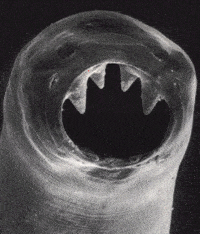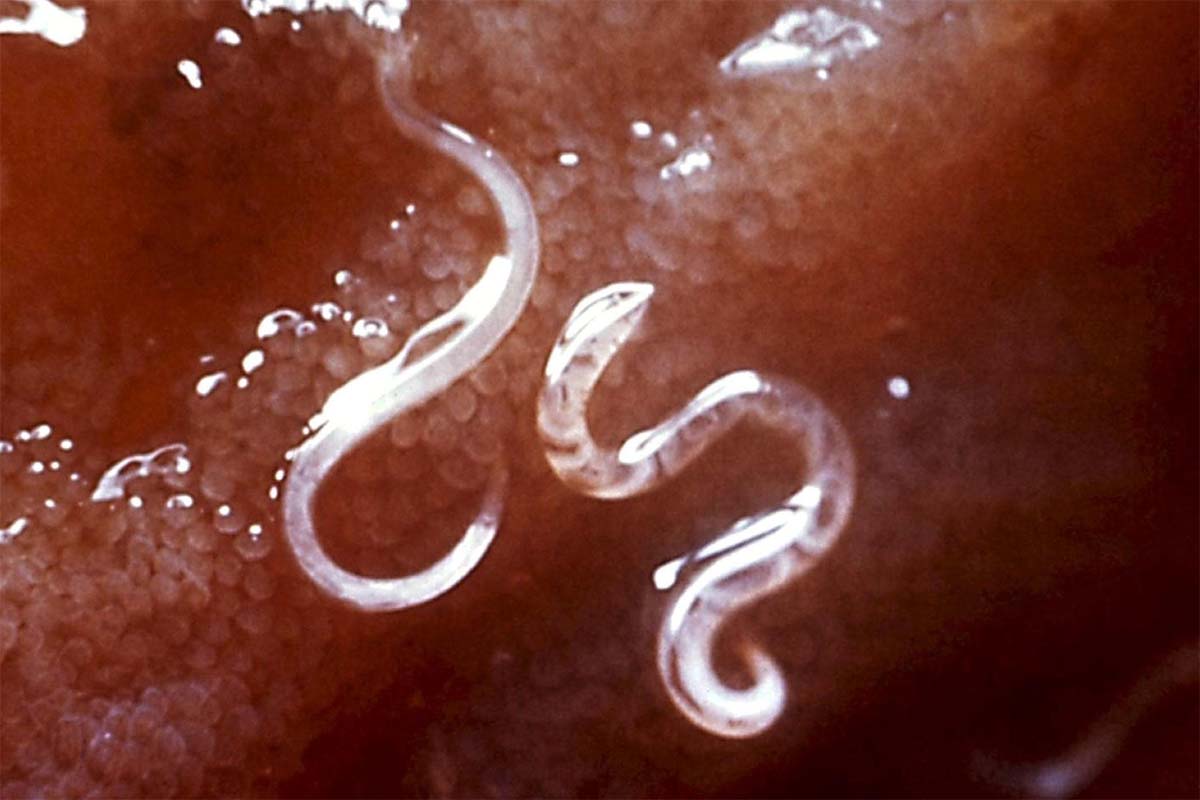About
 Hookworms are small, thin nematodes that are approximately 10 to 20 mm in length. They are a common intestinal parasitic worm of dogs, but can also infect cats.
Hookworms are small, thin nematodes that are approximately 10 to 20 mm in length. They are a common intestinal parasitic worm of dogs, but can also infect cats.
Hookworms live in the small intestine of the cat, attaching themselves to the intestinal wall using teeth like hooks (hence the name) where they feed on the blood and tissue. Blood loss can lead to anaemia, intestinal bleeding, intestinal inflammation, diarrhea and even death.
There are several types of hookworms to infect cats:
- Ancylostoma braziliense
- Ancylostoma ceylanicum
- Ancylostoma tubaeforme
- Uncinaria stenocephala
Transmission
There are a number of ways cats can become infected with hookworms and it is important to understand the life cycle of hookworms, which will be explained below.
- Via the skin (penetration): When a cat comes into contact with an environment infected with hookworm larvae which can penetrate the skin, from their they migrate to the intestine where they mature. This is known as percutaneous infection.
- Ingestion: Cats can also become infected by ingesting infective larvae in the environment, during grooming or via contaminated water and food.
- In utero: Worm eggs may be passed on from mother to her unborn puppies via the placenta. It hasn’t been established if this is the case with feline hookworms yet.
- Transmammary: Again, in dogs, it is possible for hookworm infection to be passed to her puppies via the breast milk. When a dog becomes infected with hookworms most of them migrate to the small intestine. However, some enter other tissues of the body, becoming dormant for years. When the animal becomes pregnant, they migrate to the mammary glands and are passed through the milk. It hasn’t been established if this is the case with cat hookworms yet.
Life cycle
Hookworm eggs are passed into the environment via the cat’s stool. Depending on conditions, within 2 – 5 days these eggs hatch into infective larvae (immature worms) at which time they can infect a passing cat.
Once the cat comes into contact with infective larvae, they travel to the small intestine where they hook onto the wall and mature. When they have reached maturity, they lay hundreds of eggs, which are passed out in the feces. Hookworm eggs can survive for a long period of time in the environment.
Symptoms
Symptoms of hookworms vary depending on the severity of the infection and the type of hookworm involved. In some cats, no symptoms are apparent. When symptoms do appear, they typically include:
- Black or bloody stools due to bleeding in the intestines.
- Anemia (weakness, pale gums).
- Diarrhea.
- Poor coat condition.
- Skin irritation, especially on the feet where hookworm larvae penetrate the skin.
- Weight loss.
- In kittens, stunted growth.
Diagnosis
Your veterinarian will be able to diagnose hookworm via fecal flotation. A stool sample from your cat is mixed with a liquid solution, any eggs present in the feces float to the top. These are collected and viewed under a microscope to determine the type (hookworm, roundworm etc) and a number of eggs present.
Are hookworms dangerous to cats?
Hookworms are more prevalent in dogs than they are in cats, and when cats do have them, they are more likely to be in smaller numbers. Any worm infestation should be treated immediately. As hookworms feed on the cat’s blood, cats can become anaemic. Adult cats are more resistant to hookworms than kittens.
Treatment
There are many effective medications to treat hookworms. Your veterinarian will be able to recommend an effective product. Most worming medications come in two forms, either topical which is applied to the skin on the back of the neck or tablet form.
Severely infected kittens may require hospitalisation and blood transfusions to treat anemia.
See end of article for a guide to worming products.
Do I need to worm my indoor-only cat?
This is a debatable topic and veterinarians seem to vary in their opinion. Generally speaking, it is recommended that you worm your cat from time to time (once or twice a year) as it is possible to transport worm eggs into the house via our shoes. Speak to your own veterinarian if you are unsure if you should worm your indoor-only cat.
Can I catch hookworms from my cat?
You can, although they can’t develop into the adult form as they do in cats. The infective larvae are found in the soil or sandy areas such as beaches or children’s sandpits and are able to penetrate the skin. From there they migrate beneath the skin, causing a red, itchy skin eruption. Commonly affected areas are hands, feet, between the toes and buttocks however they can migrate to the eyes, causing blindness. This condition is known as Cutaneous Larva Migrans (also called creeping eruption or ground itch). Hookworm larvae cannot complete their life cycle and die in the epidermis.

Prevention
- Regular worming, as recommended for the particular brand of worming product you are using. All cats in the household should be wormed at the same time.
- Regular cleaning and removal of fecal waste in your cat’s litter tray.
- Preventing hunting in cats.
- If you do allow your cat to go to the toilet in your garden if they do clean up any feces quickly.
- If you are planning to breed your female cat, she should be de-wormed two weeks prior to breeding and receive another dose late in pregnancy.
- Kittens should be wormed from two weeks of age and then every two weeks until they are 12 weeks old.
Adults and children should avoid walking barefoot in areas which have been defecated in by animals.
Quick guide to cat worming products
| Brand name/active ingredient | Parasites treated | Age/pregnant etc |
| Advocate/Advantage Multi (Imidacloprid and Moxidectin) Spot on (monthly)
|
Fleas (adult), roundworms, hookworms, lungworm and ear mites. Heartworm preventative. Does not treat tapeworm. | 9 weeks old. Safe use on pregnant and lactating females has not been established. |
| Aristopet (Praziquantel and Pyrantel embolate)Tablets | Roundworm, hookworm and tapeworm. | 6 weeks old. Can be used on pregnant and lactating females. |
| Excelpet (Praziquantel and Pyrantel Embolate)Tablets
|
Roundworm, hookworm and tapeworm. | 6 weeks old. Can be used on pregnant and lactating females. |
| Heartgard (Ivermectin and Pyrantel) Chews | Roundworm, hookworm, heartworm preventative. | 6 weeks old. Can be used on pregnant and lactating females. |
| Milbemax (Milbemycin Oxime and Praziquantel)Tablets | Roundworm, hookworm, tapeworm. Heartworm preventative. | 6 weeks and over 500g. Can be used on pregnant and lactating females. |
| Panacur (Fenbendazole)Tablets and paste | Tapeworm (Taenia taeniaeformis species), roundworm, hookworm, whipworm, lungworm and giardia. Does not treat Dipylidium caninum tapeworm. | Can be used on pregnant and lactating cats and kittens over 2 weeks. |
| Popantel (Praziquantel)Tablets | Roundworm, hookworm and tapeworm. | Can be used on pregnant and lactating cats and kittens over 6 weeks. |
| Profender (Praziquantel and Emodepside)Spot on (monthly) | Roundworm, hookworm, tapeworm and lungworm. | 8 weeks and over 500g. Can be used on pregnant and lactating cats. |
| Purina Total Care (Pyrantel embolate and Niclosamide)Paste and tablets | Roundworm, hookworm and tapeworm. | 6 weeks old. Can be used on pregnant and lactating cats. |
| Revolution (Selamectin)Spot on (monthly) | Fleas (adult, larvae and eggs), intestinal worms (except tapeworm), lungworm and ear mites. Heartworm preventative. Does not treat tapeworm. | 6 weeks old. Can be used on pregnant and lactating females. |

